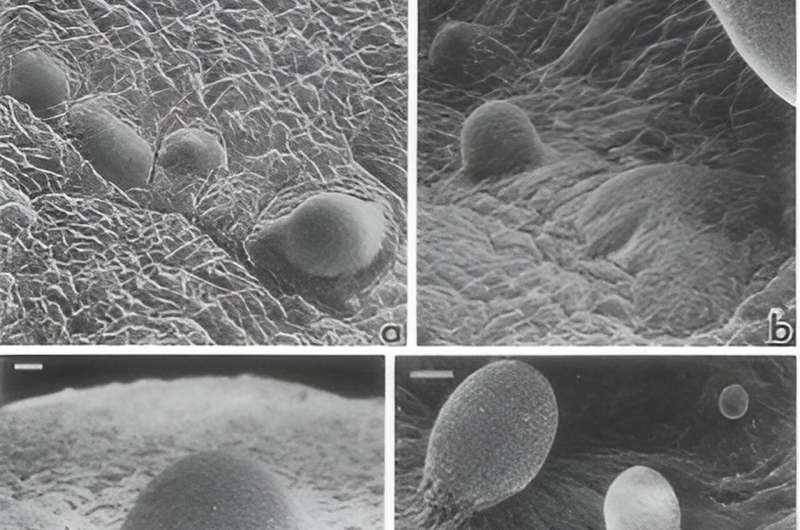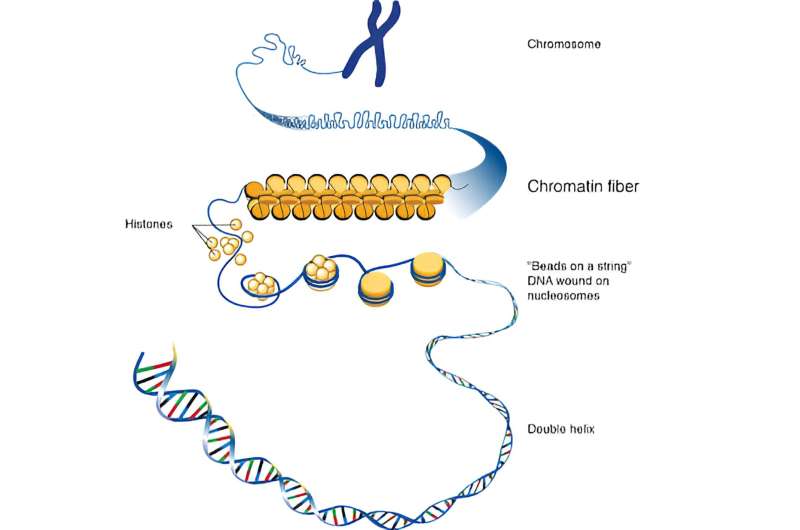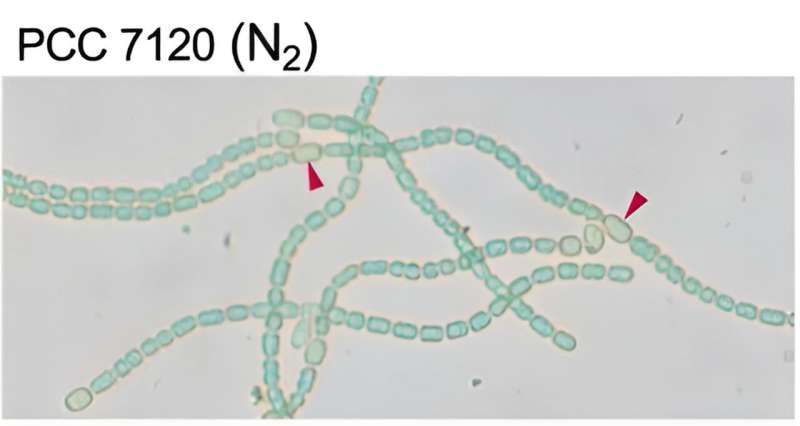This article has been reviewed according to Science X's editorial process and policies. Editors have highlighted the following attributes while ensuring the content's credibility:
fact-checked
trusted source
proofread
Why eukaryotes, not bacteria, evolved complex multicellularity

Prokaryotic single-celled organisms, the ancestors of modern-day bacteria and archaea, are the most ancient form of life on our planet, first appearing roughly 3.5 billion years ago. The first eukaryotic cells appeared around 1–1.5 billion years later. However, eukaryotic cells have since diversified into many complex, multicellular organisms that we see around us every day—fungi, plants and animals—while prokaryotes have remained decidedly unicellular.
Multicellular morphologies have evolved over 50 times in the history of life on Earth, across both pro- and eukaryotic lineages. Indeed, some prokaryotes have achieved versions of multicellularity—for example, some photosynthetic cyanobacteria partition labor into two cell types, where one cell type carries out photosynthesis while the other fixes nitrogen. Meanwhile, myxobacteria form multicellular fruiting bodies as a part of their complex life cycle.
Yet, despite that fact that some prokaryotes have skirted complex multicellularity with these multicellular lifestyles, no prokaryotic lineages have achieved complex multicellularity in the way that eukaryotes have—with several kinds of cells working together and organizing into a larger organism.
Indeed, complex multicellularity has only evolved five separate times, always within eukaryotes. This observation underlies a fundamental question in evolutionary biology: although prokaryotic cells have complex cellular structures and behaviors and have had plenty of time to evolve complex multicellularity, they have never done so—why not?
The genetic key to multicellularity
One theory for why only eukaryotes have evolved complex multicellularity is that only eukaryotes have evolved properties that are essential for complex multicellularity. Eukaryotic cells differ from prokaryotic cells in many ways—they are larger, have a larger number of different organelles and a packaged-up nucleus.
The range of forms and functions of eukaryotic cells is also staggering compared to prokaryotes. These include rigid-walled plant cells, elongated, spiky neurons and ciliated cells lining the walls of our guts.

Generating the diversity of form and function seen in eukaryotic cells requires special mechanisms—namely, sophisticated means of genetic regulation. Cells need to be assigned their specific roles during development.
In eukaryotes, DNA in cells is wrapped tightly around proteins called histones, which, in turn, are packed together into a structure known as chromatin. These kinds of regulatory mechanisms are thought to have given eukaryotes a leg up in evolving into complex multicellular organisms.
Modifications to the histone proteins regulate gene expression during development in all animals, including the most ancient—sponges. In 2017, researchers from the University of Queensland in Australia showed that a species of sponge has extremely ancient regulatory landscape that is also found in other animals that evolved much later.
The sponge, Amphimedon queenslandica, is morphologically very simple. Nevertheless, researchers found regulatory systems that are important for the development of other, more morphologically complex animals. One of these is called the Polycomb Repressive Complex 2 (PRC2), a collection of proteins that can modify histones to silence sections of chromatin. The PRCs can help cells reach and stick to a particular form, developing into the same kind of cell across cycles of division, which could have facilitated the evolution of complex multicellular organisms.
Expand your genome, expand your morphology
Still, cellular properties may not be everything. New research suggested that the evolution of complex multicellularity could also come down to an invisible yet powerful force: genetic drift. Every population is made up of individuals of the same species, but with variants of certain genes.
The frequencies of different gene variants can change based on selection, but also due to random chance. Genetic drift describes this random change, whose effects are particularly strong in smaller populations with a lower effective population size, the number of individuals that produce the next generation.

As individual cells are separated into groups of cells during the evolution of complex multicellularity, the effective population size decreases, strengthening the effects of genetic drift. Importantly, pro- and eukaryotes tend to respond differently to drift.
Prokaryotes' genomes often shrink in the face of drift, due, in part, to an inbuilt bias for gene deletion, while eukaryotes do the opposite. In eukaryotes, drift often leads to genomic expansion, whereby entire sections of DNA are added into the genome. Prokaryotes may also accumulate genes due to drift, but these are usually pseudogenes—sections of DNA that look like genes, but do not actually encode a protein.
Genomic expansion can be a strong driver of evolution, since it expands the genetic sandbox in which evolutionary innovations can be tried out. Researchers used cyanobacteria as an example; they comprise a group of bacteria where simple multicellularity has evolved in some members through a set of key adaptations.
They found a strong positive correlation between the number of multicellular adaptations and genome size across almost 200 species of cyanobacteria, suggesting that larger genomes are important for multicellularity among cyanobacteria.
In addition to a strong positive correlation between multicellular adaptations and genome size, the researchers also found that multicellular cyanobacteria have more than double the number of pseudogenes compared to unicellular species. This demonstrates that their genomes are likely experiencing drift-induced erosion as a consequence of multicellular adaptation, which is also expected for prokaryotic organisms such as the cyanobacteria.
Although many hypotheses have been proposed, it is still not entirely clear why only eukaryotes have evolved complex multicellularity. Moreover, whether genomic erosion due to drift is an insurmountable obstacle for the evolution of multicellularity in prokaryotes is not known either.
Altogether, we are still far from a fundamental understanding of how and why complex multicellularity evolved in eukaryotes, and which features were most important for major morphological transitions. However, these remain fascinating questions in evolutionary biology because the answers can give us a glimpse into the events leading up to our own origins, hundreds of millions of years ago.
Provided by American Society for Microbiology





















